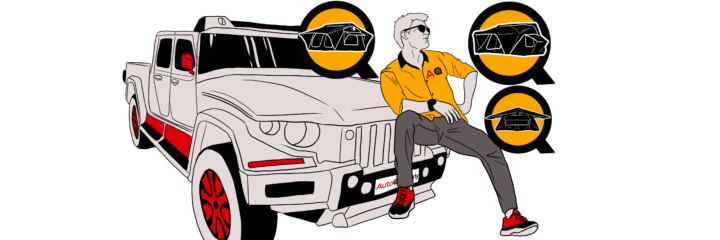Camping is the most relaxing experience you can have without four margaritas and a hot tub. Or with four margaritas, we don’t judge your camping preferences. Setting up camp can be a chore, though. You have to find a place where the ground isn’t covered in ants, fight with tent poles, yell into the darkness when you find out your camp hammer didn’t make it into the stake bag, etc. Wouldn’t it be nice if your tent was just attached to your car and set up in minutes?
Good news, that’s exactly what a rooftop tent is.
- Choosing the Right Rooftop Tent
- Top 10 Best Rooftop Tents 2026
- 1. Overall Best Rooftop Tent: Tuff Stuff Ranger Overland
- 2. Tepui Explorer Ayer
- 3. Best Premium Rooftop Tent: iKamper SkyCamp 2.0
- 4. Best Hybrid Rooftop Tent: iKamper X-Cover
- 5. Best Budget Rooftop Tent: Smittybilt Overlander
- 6. Least Expensive Rooftop Tent: TMBK 3 Person
- 7. Best Large-Footprint Rooftop Tent: CVT Mt. Denali
- 8. Best Rooftop Tent/Storage Hybrid: Tepui HyBox
- 9. Best Rooftop Tent For Small Vehicles: iKamper SkyCamp Mini
- 10. Best Lightweight Rooftop Tent: Front Runner Rooftop
- A Closer Look at Rooftop Camping
- What Are You Waiting For? Get Out There!
Choosing the Right Rooftop Tent
This guide is here to help you get out there and make the most out of the beautiful rock we call Earth. In it, you’ll find quick info on choosing the perfect rooftop tent for your situation. Following that will be a review section where we will look at ten of the best tents on the market right now. Finally, at the bottom, we have an in-depth section so you can fine-tune the decision-making process. First things first, though: are you sure a rooftop tent is for you?
Why Rooftop Tents Are Awesome
We go over the finer points and compare the pros and cons here, but this is a quick start guide. We’re comfortable just telling you that rooftop tents are awesome and totally worth it. Be honest, what would you rather do? Sleep above the critters on a clean mattress, or sleep on the cold lumpy ground with the bugs? Kind of a no brainer.
The biggest downside is the cost. Rooftop tents start at a thousand dollars and go up from there. It’s still a lot cheaper than an RV or travel trailer. They are way more convenient than an RV, too, since unless your only car is a Pinto, there’s a rooftop tent that will work on your roof.
Soft Shell vs. Hard Shell Tents
Rooftop tents come in two main flavors. Soft shell tents are more like traditional on-the-ground tents. They are made of fabric and have poles that you have to snap into place. Hard shell tents use the hard case as the roof. Some you open like a briefcase, and some just pop up vertically. Here’s a quick comparison:
Hard Shell Tents
- More aerodynamic when traveling
- Faster to set up
- Better weather protection
Soft Shell Tents
- Cost less
- More spacious
- Take up less space when packed
Weight
A roof rack can only support so much weight, so when you buy a tent to mount to the roof, you need to pay attention to the numbers. Specifically, the dynamic weight your roof rack can support, the weight of the tent itself, and the total weight your car can support.
We’ll get more into mounting specifics in the deep dive at the bottom here. To keep it simple, your car’s rack has a dynamic weight, that’s how much weight it can carry while moving. Don’t get a tent that weighs more than the dynamic weight capacity. The static weight is usually many times the dynamic weight, so the total weight probably won’t be an issue. Just google your car model’s total roof weight capacity and double-check before you load it full of your entire lead fishing anchor collection.
Size
When it comes to choosing the right size, it’s all about balancing the amount of space you want and what will fit your vehicle. A small vehicle won’t be able to fit a larger tent, it’s just not possible. To get the most space, you’ll need a tent that both takes up more roof space, and folds out. That’s where the most significant advantage of the soft shell design comes into play.
Other Considerations
The most significant things to think about are type, weight, and size, but that’s not all. The following considerations probably won’t be the deciding factor, but they can help sway you one way or the other after narrowing down the options to a few.
Expected Weather
Most tents are three-season rated, which basically means they aren’t useful if it gets super cold and windy. A four-season rated tent is thick enough and sturdy enough to survive a blizzard. A three-season can survive a few winter outings, but serious winter campers will want to shell out for something a bit sturdier.
Creature Comforts
By their nature, rooftop tents are more comfortable than their ground-based counterparts. Some tents feature pockets and awnings that make setting up a base camp easy. Some rooftop units feature extra-thick mattresses. A unit with a nice ladder makes your life easier than buying a unit with a ladder that takes more work.
Ease of Setup
The speed and minimal effort required to set up camp using a rooftop tent is one of their bigger selling points, but they still vary wildly model to model. Hard shell pop up tents can be set up in seconds just by undoing the latches. Other, less expensive soft shell tents are a lot more like setting up a conventional tent. You have to open up the base and install the tent poles.
In this section, we put together a variety of great rooftop tents and reviewed them. We’ve rounded up great soft shell tents, hard shell tents, budget tents, and premium tents. There’s even a couple high tech hybrids. Hopefully, this will give you a great overview of what’s out there, and help you choose the perfect tent for your situation.
| Product | Sleeps | Weight | Footprint closed | Footprint open | Minutes to set up | Rating |
|---|---|---|---|---|---|---|
| Tuff Stuff Ranger Overland | 2 and a child/dog | 150lbs | 56” x 48” | 56” x 96” | 15 | 5 |
| Tepui Explorer Ayer | 1 | 104lb | 42”x48” | 84”x48” | 10 | 4.5 |
| iKamper SkyCamp 2.0 | 4ish | 160lbs | 55”x80” | 100”x80” | 1 | 4.5 |
| iKamper X-Cover | 4-ish | 120lbs | 47”x75” | 82”x75” | 5 | 4.5 |
| Smittybilt Overlander | 2+ | 144lbs | 56”x48” | 56”x96” | 5 | 4.5 |
| TMBK 3 Person | 3+ | 108lbs | 57”x50” | 57”x94” | 10 | 4 |
| CVT Mt. Denali | 4+ | 225lb | 87”x48” | 87”x132” | 20 | 4 |
| Tepui HyBox | 2 | 177lbs | 84”x55” | 84”x55” | 2 | 4 |
| iKamper SkyCamp Mini | 2 | 125lbs | 55”x56” | 81”x56” | 1 | 4 |
| Front Runner Rooftop | 2+ | 93lbs | 48”x53” | 98”x53” | 10 | 3.5 |
Top 10 Best Rooftop Tents 2026
1. Overall Best Rooftop Tent: Tuff Stuff Ranger Overland

Editor’s Rating:
The Numbers
- Sleeps: 2 and a child/dog
- Weight: 150lbs
- Footprint closed: 56” x 48”
- Footprint open: 56” x 96”
- Minutes to set up: 15
Highlights
The Tuff Stuff is really the perfect tent for someone just getting into the rooftop tent world. It comes with everything you need, including an install kit with tools. Nothing else does that. It’s also big enough for a small family, and comes with its own annex room for extra storage.
Review
If you just want to buy a rooftop tent and be done with it, get the Tuff Stuff Ranger Overland. It’s the entire RTT experience for a very, very reasonable price. It comes with its own annex room, something that you’d typically have to buy extra. It also comes with its own installation tools, which is nice.
What propels the Overland towards the top of our list is how well rounded it is. It’s not the best at anything. It’s not as spacious as the CVT, it’s not very lightweight – any hard shell like the SkyCamp 2.0 will survive the elements better, and there are cheaper units. At the same time, with the Ranger Overland, you aren’t compromising on any of those categories either.
It is spacious. You get a full 52″ of height to sit up and have morning coffee, and with the included annex room, you don’t have to store your clutter in the same tent compartment as you. The box doesn’t say four-seasons, but it is well built enough to withstand the winter. The material that it’s made from, 420D polyester/canvas, is plenty waterproof and sturdy enough for wind and snow. You get to be mighty comfortable during the wind and rain too, the included foam mattress is one of the thicker ones on the market.
There’s only one thing that might annoy you: the ladder. It comes with a sliding ladder that doesn’t offer enough mounting and height options. Bring a shovel with you to dig out underneath it, or swap it for an aftermarket telescoping ladder, and you’ll be fine. Honestly, the fact that our only nitpick is that the ladder isn’t amazing should tell you all you need to know.
Pros
- Excellent value
- Easy to install
- Made of good quality materials
- Lots of extras included
Cons
- Ladder could be better
- Too heavy for smaller vehicles
2. Tepui Explorer Ayer
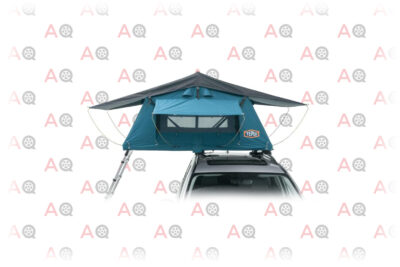
Editor’s Rating:
The Numbers
- Sleeps: 2
- Weight: 104lb
- Footprint closed: 42”x48”
- Footprint open: 84”x48”
- Minutes to set up: 10
Highlights
Tepui is one of the leaders in quality rooftop tents. The only reason this one doesn’t rank higher is because the competition is so dang good.
Review
The Tepui Explorer is a really fantastic tent. This tent rates highly based on its features, price, and quality.
One thing really holds it back, however, and that thing is the size. It’s tiny. Like really tiny, it has a smaller sleeping area than the SkyCamp Mini. At the same time, that might be its best feature. You can easily mount this to any car, just like the SkyCamp Mini, but it’s one-third of the price. It’s more than one third the quality, though, so the value is through the soft, canvas roof.
Unlike other soft shells, the Explorer Ayer is four seasons ready. It has a heavy-duty cover/awning/rain fly that will keep the wind, snow and rain off. The whole thing is made of Tepui’s favorite ultra-durable fabric blend. There’s not much more to it, it’s a basic, high-quality tent that sleeps two for cheap. It even has a great ladder, something that Tuff Stuff could learn from.
Pros
- Very lightweight
- Easy to find online
- 4 season ready
Cons
- Tiny
- Takes longer to set up than others

Editor’s Rating:
The Numbers
- Sleeps: 4ish
- Weight: 160lbs
- Footprint closed: 55”x80”
- Footprint open: 100”x80”
- Minutes to set up: 1
Highlights
The Skycamp sets up in one minute. You just open it up, and you are good to go. It’s also the most spacious hard shell tent on this list, and one of the most spacious that’s for sale.
Review
iKamper makes an appearance on this list 3 times. That’s because they all have quality and comfort that just surpasses everything else. The X-Cover is the nicest soft shell tent you can get, and the SkyCamp Mini is the coolest tiny tent ever. Meanwhile, this SkyCamp 2.0 is luxury defined.
Start with the fact that it has a full king-size mattress. See, the SkyCamp is more of a hybrid than a full hard shell design. It’s a big indestructible briefcase when it’s packed away. When you open it, though, it folds out like a soft shell and doubles in area. A process that takes seconds, by the way. With an interior roof height of 48” you won’t be standing up inside, but you’ll definitely be able to sit up and have a beer while watching the sun go down.
The downside is the price. This is a premium product, and it has a premium price tag, so it’s not surprising that the unit is expensive. It is such a good unit though, they thought of and solved a ton of problems that you probably didn’t even know were problems. Stuff like the ladder rungs have a slight angle, so you know the perfect position to set it at, and the back is padded so you can use it as a headboard.
If the price is the biggest issue, then choose if you want to sacrifice durability or luxury. If you can sacrifice luxury, go for the HyBox. If you don’t need the hard shell, iKamper makes the soft shell X-Cover. If you can’t live without either, you won’t be disappointed in the Skycamp.
Pros
- A lot of space, especially for a hard shell
- Extra comfortable
- Ultra-fast set up
- Four-season ready
Cons
- Expensive
- A bit on the heavy side
4. Best Hybrid Rooftop Tent: iKamper X-Cover
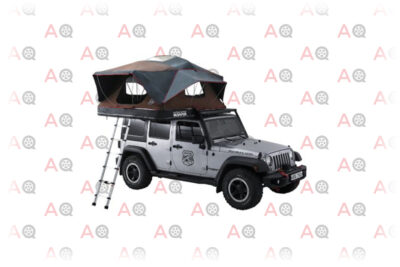
Editor’s Rating:
The Numbers
- Sleeps: 4-ish
- Weight: 120lbs
- Footprint closed: 47”x75”
- Footprint open: 82”x75”
- Minutes to set up: 5
Highlights
The X-Cover has all the benefits of a soft shell rooftop tent. It’s light, compact when folded but spacious when open, and can be totally opened up for maximum ventilation. Unlike most soft shell tents, though, it can be set up in a few minutes. Due to the combination of its soft-shell design and its quick deployment, it’s referred to as a hybrid rooftop tent.
Review
iKamper’s second entry on this list is the X-Cover. It’s easiest to compare it to the SkyCamp, because honestly, they are nearly identical in terms of perks. Same ladder, same amazing king size mattress, same high-quality construction. The X-Cover has some advantages over the SkyCamp, though. First off, it’s cheaper. Second, it has more room inside of it. It takes full advantage of the interior height, unlike the SkyCamp’s lean-to design. Finally, it weighs 40lbs less. That’s an extra case of wine you can take with you.
It’s not as durable or compact as the SkyCamp, and it takes longer to set up. That being said, the X-Cover is still the fastest soft shell tent to set up on this list. The website claims people can do it in 3 minutes, but field testing indicates that the number is really closer to 4 minutes. If your buddy bought a Smittybilt because he breathes Jeep lifestyle, you’ll have enough time to set up, grab a drink, climb into your extra comfortable tent and heckle him as he wrestles with tent poles.
It’s not all sunshine and lollipops, though. While the X-Cover is cheaper than the SkyCamp, it’s still expensive. We made fun of how long it takes to set up the Smittybilt, but you could buy 3 of them for the same price. That puts the X-Cover in a weird place. It’s a high-end soft shell RTT that costs the same as many hard shells. One of the defining advantages of the soft shell tents is the lower price, and it doesn’t have that. It’s noisier, not as durable, and not as convenient, but costs the same.
Being in a weird place value wise is not enough of a reason to dislike it, though. It’s still one of the nicest units on this list, and you will absolutely feel like a king lording over your subjects as you watch the world from atop your rooftop castle.
Pros
- A lot of interior volume
- Very comfortable mattress
- High quality
Cons
- Expensive
- Noisy in the wind
5. Best Budget Rooftop Tent: Smittybilt Overlander
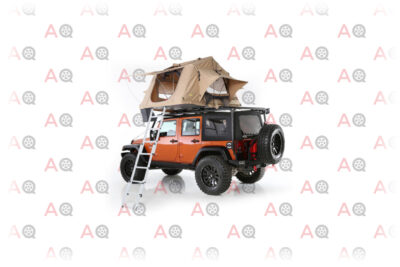
Editor’s Rating:
The Numbers
- Sleeps: 2+
- Weight: 144lbs
- Footprint closed: 56”x48”
- Footprint open: 56”x96”
- Minutes to set up: 15
Highlights
Highlight? It’s about a thousand dollars for a full-function, good quality tent. What more do you want?
Review
Jeep people are in a cult. A cult that values rugged, offroad, and tactical over wimpy things like “easy” and “comfortable.” Smittybilt is a company that is closely associated with the Jeep lifestyle to the point where some of their most famous products are Wrangler specific. The good news is that their rooftop tent (or RTT), the Overlander, is not Jeep specific. It will clamp to a 4Runner with just as much ease as a Liberty. But that Jeep mentality bleeds through the tent’s design, and that’s fantastic.
What we mean is that it’s a very straightforward, no-nonsense unit. It’s made of good quality material so it can withstand the trails, and the construction is solid enough that it can take a beating when the weather gets uppity. It has enough space for two people and their dog, and the ladder is extra wide. It’s also got cool little features that you don’t find in other units, like LED lights and 12v hookups.
The biggest selling point is the price, though. It doesn’t have the amazing space that the X-Cover has, or the included extras of the Tuff Stuff. It’s impossible to be disappointed with the quality, though, and it’s nearly the cheapest thing on this list. It’s the best value on this list, the only cheaper RTT is actually cheap and not just inexpensive.
They can afford to sell it so inexpensively because they got rid of the easy part of the equation. It’s a Jeep thing. It takes a long time to set up. The rugged, sturdy, no-nonsense shape is set up by erecting a bunch of aluminum poles, and that takes time to do. It’s also not the easiest thing to install initially. Premium setups like the SkyCamp come on their own frame that just clamps right onto an existing rack. The Smittybilt only comes with some bolts and a cheap wrench.
If a little bit of DIY doesn’t scare you, though, this is a great deal.
Pros
- Inexpensive
- Good quality
- Has internal lighting
Cons
- Not the easiest to set up
- Heavier than other small soft shells
6. Least Expensive Rooftop Tent: TMBK 3 Person
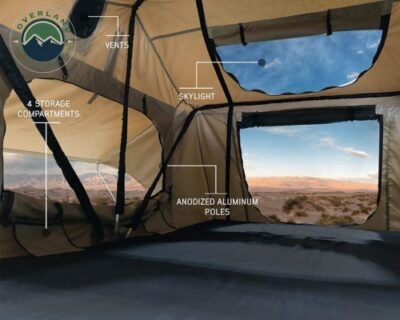
Editor’s Rating:
The Numbers
- Sleeps: 3+
- Weight: 108lbs
- Footprint closed: 57”x50”
- Footprint open: 57”x94”
- Minutes to set up: 10
Highlights
This is the only rooftop tent we are willing to recommend coming in at less than a grand. Suppose you don’t know whether or not you will actually enjoy the rooftop experience. In that case, it’s hard to justify paying a premium price.
Review
It’s less than a thousand dollars and is available on Amazon. There isn’t a whole lot more that needs to be said. Honestly, it feels like every criticism can be countered with “yeah, but it’s so cheap!” It’s slow to set up, but of course it is. It’s not amazingly durable, but of course it’s not. It’s cheap. It’s also got flimsy installation hardware.
That’s not to say it does everything poorly. It’s a completely adequate tent for a hobbyist. It’s one of the lighter tents on the list, and the size is actually on the bigger side as far as lightweight, inexpensive tents go. You won’t regret buying it, which we think is the best indicator of whether or not something is worth recommending. It’s good enough that it does do everything the box says it will do. You get a tent that mounts to your roof.
The only suggestion we have is that if you are new to the RTT scene and just want to test the waters, so to speak, take a hard look at the Smittybilt. It’s not much more expensive, but it’s easier to set up and a lot stronger.
Pros
- Cheap
- It has a good amount of interior room
- Lightweight
Cons
- Cheap
- Poor-quality hardware
7. Best Large-Footprint Rooftop Tent: CVT Mt. Denali

Editor’s Rating:
The Numbers
- Sleeps: 4+
- Weight: 225lb
- Footprint closed: 87”x48”
- Footprint open: 87”x132”
- Minutes to set up: 20
Highlights
It’s got two rooms. The CVT Mt. Denali is so big that it’s got two rooms. If you have kids and you want them to be somewhere not where you are when they wake up and want hot chocolate before you have coffee, there’s a wall between you. They’ll even have their own ladder, because the CVT comes with two of them.
Review
Most rooftop tents are small. Even the bigger ones like the X-Cover are still somewhat small. They say they can fit 4 people, but no one wants to sleep like a sardine in a can. Enter the CVT Mt. Denali. They claim it sleeps 4, and that’s probably a stretch. We’ll restate this because it’s a little crazy, but it’s got two separate rooms. If you include the person-sized annex room, it’s got three bedrooms.
What’s nice is that it’s not just big, it’s also a quality tent. They didn’t just go for size and neglect the rest of the unit. It has some really neat features that we wish were included in other tents. The center of the roof is a clear panel so you can lay beneath the stars and watch the satellites go by. Also, the ladders are enclosed in the annex room, so you can climb out of the weather. It’s a minor thing, but if it’s storming and you need to get into your vehicle, you don’t have to go outside the tent.
The size is the biggest problem with the CVT. You will need a heavy-duty roof rack on a heavy-duty vehicle to lug the thing around. That’s probably not a problem if you plan on camping with your family. After all, an SUV is sort of the de-facto vehicle for a family adventure. What might pose a bigger problem is that it weighs a whopping 225 pounds and takes up a ton of space. That means you need help getting it on and off, and you need a ton of storage room just to keep it around.
Think of it like backpacking: more space is the same as more inconvenience. The CVT takes a long time to set up, takes a lot of muscle to manage, and even cleaning it will take extra time. If you don’t need the space, the Tuff Stuff also has an annex and is way easier to manage. Either that, or pay the extra money for the SkyCamp that still has tons of space but can be set up in one-tenth the time.
Pros
- Humongous
- Has separate rooms and lots of extras
- Windows are large and plentiful
Cons
- You need a big vehicle to carry it around
- You also need big muscles to take it on and off
8. Best Rooftop Tent/Storage Hybrid: Tepui HyBox
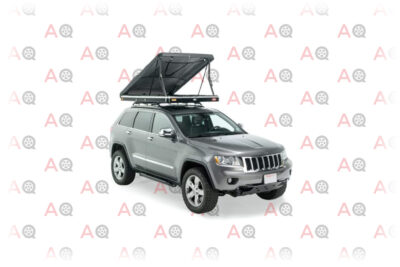
Editor’s Rating:
The Numbers
- Sleeps: 2
- Weight: 177lbs
- Footprint closed: 84”x55”
- Footprint open: 84”x55”
- Minutes to set up: 2
Highlights
On a smaller SUV, or other small overland rigs, storage space is at a premium. That makes one the main disadvantage to hauling a rooftop tent the fact that it takes all your rooftop cargo space away. The HyBox solves that problem by being both a storage box and a tent, perfect for compact adventure vehicles.
Review
If you allow us, we will start with the bad. That’s because it’s probably the biggest deal-breaker when it comes to an RTT, so it’s better to rip off the bandaid. The HyBox has the least amount of room out of any tent on this list when set up. The 51″x81″ sleeping area is ok for two people, that’s about standard. It’s the super low 3ft ceiling that makes it feel more like a Japanese pod hotel than an idyllic wilderness cabin.
That being said, if your only goal is to sleep, it’s fine. It’s still a huge upgrade over a tiny conventional tent, you just won’t want to wait out any storms in it. Which is a shame, because it can withstand them fine. It’s got a hard composite roof that will protect you from hail or severe weather, and the fabric can withstand wind for days. That’s one of Tepui’s features as a brand, they like their space-age ultra-durable fabrics. Both on this hard shell unit, or their soft shell unit we list here.
The biggest feature of the HyBox isn’t its toughness, though. It’s the fact that the HyBox is also a rooftop storage box. Instead of popping it up fully, it’s hinged on both sides and can be opened like a trunk. In fact, you can just unzip the walls from the base and convert it fully into a storage box. That makes the HyBox the most reasonably-priced tent to leave permanently attached to your vehicle on the market.
As far as comforts go, the HyBox is fine. Tepui is no stranger to making great tents, and unlike their other offering on this list, the HyBox only takes a few minutes to set up. Inside, you get all the basics: windows, a ladder, a foam mattress, and not much else.
It is heavy, though. That’s why the SkyCamp Mini is really the only great hard shell option for small cars. The HyBox would steal the show with its extra storage space, but there’s no way for this 180lb unit to bolt to the average small crossover or wagon. For two intrepid explorers in a medium SUV, though, the HyBox is perfect.
Pros
- Very durable, four-season-ready construction
- Set up takes minutes
- Doubles as a storage box
Cons
- Low ceiling height
- High install weight
9. Best Rooftop Tent For Small Vehicles: iKamper SkyCamp Mini
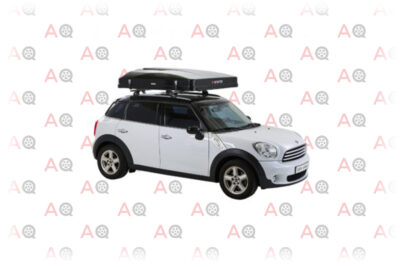
Editor’s Rating:
The Numbers
- Sleeps: 2
- Weight: 125lbs
- Footprint closed: 55”x56”
- Footprint open: 81”x56”
- Minutes to set up: 1
Highlights
If you long for the luxury of the SkyCamp 2.0, but own a small Subaru or similar that would be crushed under the weight of the bigger unit, get the SkyCamp Mini. It sleeps two, has the same high-quality construction, and is fully ready for whatever the weather has in store.
Review
iKamper is at it again, this time with another hard shell luxury tent that looks really good in addition to being very nice to sleep in. Unlike the SkyCamp 2.0, this one is half the size. It also comes in at a very manageable 125lbs. That weight is important since it’s more or less the cutoff for most basic roof racks. If you have a wildly popular Subaru Crosstrek or Mini Clubman, you don’t have to make any modifications for the SkyCamp Mini. The only way to get that kind of convenience elsewhere is to go soft shell, but you’d be sacrificing the durability and speed of the iKamper.
The Mini is smaller than everything else on this list due to clever engineering, but is average-sized when set up. It’s actually bigger on the inside than both the HyBox and the Explorer, so you can very comfortably fit two people. The foam mattress is best in class, and like the rest of the iKamper models, it’s insulated.
That’s actually something we didn’t mention in the other two iKamper reviews, but it’s worth talking about. The floors, walls, and hard lid all have a thin layer of insulation. Unlike your average nylon tent, the SkyCamp Mini will stay quite warm during cold nights. Unfortunately, you wouldn’t want to be up there in the heat: the insulation is good, but the lack of cross breeze can get stifling. The compact, clamshell nature of the Mini means you don’t get many window options.
Unfortunately, it shares SkyCamp’s high price. You have to fully commit to wanting luxury at all costs to validate purchasing the Mini when you could probably make other lightweight tents work. The Tepui Explorer weighs less and is smaller folded up, you don’t even have to make something work. Nothing else will look as good above your short bed truck, or bolted to your WRX.
Pros
- Very compact when folded up
- Luxurious
- Sets up in minutes
Cons
- Expensive
- Windows are tiny
10. Best Lightweight Rooftop Tent: Front Runner Rooftop

Editor’s Rating:
The Numbers
- Sleeps: 2+
- Weight: 93lbs
- Footprint closed: 48”x53”
- Footprint open: 98”x53”
- Minutes to set up: 10
Highlights
For those who want to install the tent, do your camping thing, then come back and remove it, the Front Runner is perfect. It’s ultra-lightweight and has quick-release clamps for mounting.
Review
The Front Runner is very basic. That’s not bad, it does do everything a tent should do. It keeps bugs out and most of the water. It just lacks the fit and finish of the Tepui, or the cool features of the Tuff Stuff. The fact that it directly competes with the Ruff Tuff in terms of size and complexity doesn’t help. They share the same ladder issues, but the Front Runner doesn’t have an annex room.
What it does have is the lightest weight out of any RTT out there. It’s 30lbs lighter than the SkyCamp Mini. That makes it totally manageable if you are just a one-person operation. They seem to have run with that motif too. The way the Front Runner installs onto a rack is probably one of the most straightforward ways possible. You just line it up and clamp.
You have to make a lot of sacrifices for that usability, though. For one thing, it has a fairly thin mattress. For another, even though the box claims three people, it’s smaller than some of the two-person tents. The weight really is the most significant selling point of the Front Runner, which is where the comparisons get really ugly. The Tepui Ayer is only ten pounds heavier and is a lot more durable. It’s also a lot more comfortable. The difference in price between the two is negligible, so it’s hard to justify the Front Runner if you are just looking for a basic tent.
Still, if you are camping in moderate climates and plan to take the tent on and off a lot, you’ll be delighted with the Front Runner.
Pros
- Very lightweight
- Easy to mount
- Very open and breezy
Cons
- Thin mattress
- Ladder sucks
A Closer Look at Rooftop Camping
Rooftop tents are fairly straightforward in application. It’s a tent that bolts to your roof. As you can see by the variety of options in our guide above, there are still tons of options to choose from. Our quick guide above hits all the major decision-making points, but leaves out a lot of the details. If you are still thirsty for more knowledge, we put together this section to find those details we left out before.
The Pros and Cons of a Rooftop Tent
The most difficult decision for buying a rooftop tent is the decision to want one at all. Compared to sleeping on the ground in a conventional tent, a rooftop tent is a complicated, expensive, and heavy piece of extra gear. To make the decision easy, here are some of the significant pros and cons explained.
The Disadvantages of Rooftop Tents
We figure it’s easier to start with the cons. If you see any of these and they are an immediate deal-breaker, you’re done. Go enjoy sleeping on the ground. If you make it through, you’ll be showered in the advantages and really feel like it’s worth it.
They Are Expensive
A cheap conventional tent is around 50 bucks. A cheap rooftop tent is $1000.
They Are Difficult to Manage
The average weight of a rooftop tent is 150lbs. That’s hard to take on and off, especially alone. They are also big and take up a ton of space, so you need a good amount of room to store them when they aren’t on your vehicle.
You Have to Climb a Ladder
This one’s straightforward. If for whatever reason you are not comfortable climbing a ladder, then rooftop camping is not for you.
You Can’t Stake a Claim
One of the advantages of setting up a tent on the ground is that it marks your space. That gives you a home base to come back to. When your car is your tent, if you ever leave your camping space, you lose your claim.
You Have to Break Camp to Move
Similar to above, a conventional tent can just sit there on the ground while you drive off to explore. A rooftop tent has to be broken down and packed up before you can move.
The Rooftop Advantage
With the disadvantages out of the way, we can look at the reasons rooftop tents are awesome.
They Get You off the Ground
The ground is cold, lumpy, and full of bugs. It’s nice to be off it.
They Are Comfortable
Even the more inexpensive rooftop tents come with their own mattress attached to a flat, even surface. No rocks or ant hills to put a kink in your back.
They Are Easy to Level
Unlike conventional tents where you are at the mercy of the terrain, you can just drive to a level spot, and you are ready to go.
They Are Clean
This is one of those advantages you don’t really get until you experience it. Camping is supposed to be dirty, right? With a rooftop tent, you have to get up a ladder out of the dirt to get in, and you leave a lot of the mud and grime behind. That keeps everything much nicer inside the tent.
Most Are Faster to Set Up
This isn’t true for all scenarios. Pop-up tents that you just throw on the ground couldn’t be simpler, so no rooftop will compete with that. However, the average rooftop tent is as fast as folding it out and attaching the ladder. Some have hydraulics and set themselves up, so if you don’t feel like fighting fiberglass poles, you don’t have to.
Mounting
The hardest part about owning and using a rooftop tent is the part where you actually have to attach it to your vehicle. There are two key components to the process. The first is specific to the actual tent you buy, and that’s the clamps and rigging system that the tent comes with. The second part is the part that you are more in control over, the rack on your vehicle.
All About Racks
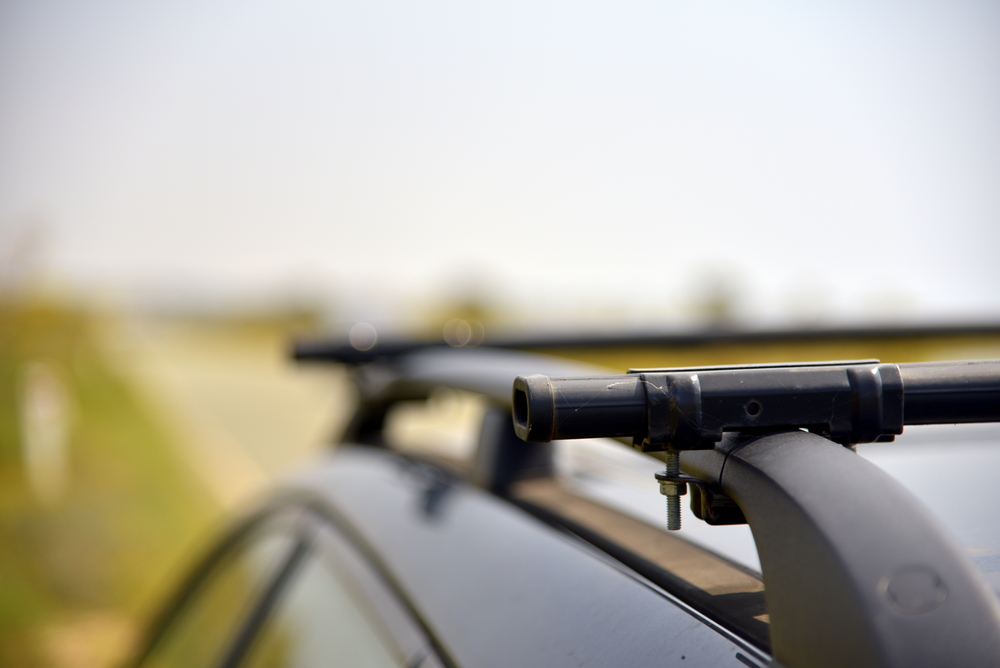
There’s actually a lot of variety when it comes to mounting systems. We’ll touch on them here, but you will likely have to research your own vehicle’s system (they’re usually car-manufacturer specific) to know exactly what you’re dealing with.
Factory Roof Rack
The easiest, most straightforward way to mount anything to a car is to buy a car with a factory roof rack option. They probably won’t be strong enough for the bigger RTTs, but they will be fine for most. Largely because the average capacity for a factory rack is 150lbs, and since you always want to be on the safe side, even the lightweight SkyCamp Mini is pushing it.
Aftermarket Roof Rack
These racks are ones you purchase and install yourself. They vary wildly, and you may have to do some research to find out what the capacity is. If you are looking to buy one, Popular Mechanics has a great overview here.
A subsection of the aftermarket racks are homebrew racks. Lots of off-road rigs have their own roll cages that make it easy to bolt a tent frame onto or weld in a couple of cross members to mount cargo wherever you want. Jeeps have no less than thousands of aftermarket solutions for mounting cargo, tents and lights. Don’t think you have to have a roof rack, specifically, the world of offroad fabrication has no limits.
Truck Bed Rack
Truck racks are trendy in the Overlanding scene. They allow you to mount a rooftop tent, or large cargo pod, above the bed, so you don’t sacrifice any storage and don’t have to have objects above the cab. Tuff Stuff, the maker of our number one pick for an RTT, makes a great truck mounted rack you can pick up here.
Cargo Carriers
If you’ve got enough roof space and you’re headed for a larger journey, it’s a fantastic idea to pick up an auxiliary roof cargo rack or cargo carrier specifically designed to load equipment and cargo. Whether you’re a rock climber, hiker, kayaker, or you’re just looking for some more camping equipment space, mounting a cargo carrier alongside your tent can provide the space to make the transition from weekender to full-time adventurer.
Bike Racks
Plenty of four-wheeled adventurers love two-wheel adventures as well, mountain biking, road biking, and cycle-touring the entire country. If you’re getting ready for more serious outdoor adventures with a rooftop rack, also consider installing a bike rack on your vehicle that makes hauling your bicycles easy, convenient, and safe.
Maximum Roof Load
The dynamic load of the rack is really important when choosing a tent to mount. It’s probably the most important; imagine the embarrassment of spending a few thousand dollars on an RTT only to have it fly off while driving on a mountain road.
It’s not the only number you need to consider, though. Most vehicles have a maximum roof load in addition to a maximum dynamic load. Trucks and SUVs have ratings well into the thousands, so 200 pounds of tent and 400 pounds of person aren’t going to be an issue. Smaller crossovers and cars, though, can have roof loads that dip below 500lbs. That’s not a lot of weight once you add the rack, tent, and bodies.
The only thing that kind of sucks is that sometimes the actual number can be hard to find. The Crosstrek, a very popular RTT platform, doesn’t list it in the owner’s manual. That makes searching for other people with similar cars and setups the best option for knowing if a setup will work for you. A google search with your car model and rooftop tent will almost always lead to forums or posts with people’s experience doing something similar to what you want to do.
Quick Tips for RTT Camping
If you are ready to hit the trail, here are some quick trips to make your experience the best it can be. We’ll refrain from general camping tips since this is an automotive site, but if you want those, KOA has you covered here. We don’t mind plugging them because they make perfect places to take a vehicle with a rooftop tent.
- Bring Leveling Blocks
They can just be some 2×6 chunks of wood that you drive up onto, or you can buy plastic ones like these.
- Bring a Shovel
Especially if you have a sliding ladder instead of a telescoping ladder. You might have to dig a little to get a good angle for the ladder. - Always Do A Trial Run
Do a trial run in your driveway so you know if there are any issues. Do two, and give it a good shake to make sure it’s not going to come off while you drive. - Hang a Bag From The Top of The Ladder
Some tents, like the Smittybilt, come with their own shoe bag. Most don’t. Just tie one to the top of the ladder. That way you don’t track mud into your tent, but your boots are still easy to get too. - Stash Spare Keys
Especially if you have a locking tent like the SkyCamp, Mini or 2.0, hide a spare key to the tent in the car. You can also hide a spare car key in your tent.
What Are You Waiting For? Get Out There!
Rooftop tents are the ultimate balance between RV luxury and rugged, at-one-with-nature camping. If you are sitting on the fence about it, get off the fence and into a rooftop tent. Then go exploring. When you have a self-contained, fully independent camping rig, roads lose their meaning, and the world becomes unlimited.
